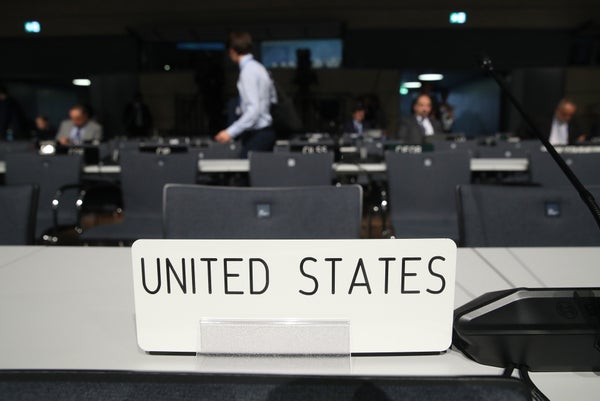A giant star-spangled pavilion sits outside the formal negotiating area for the U.N. climate meeting in Bonn, Germany, which began this Monday. American-accented English dominates the potpourri of languages there, and power-suited representatives from U.S. cities, states and businesses mingle with their foreign counterparts. Above it all hangs a giant banner with a hashtagged slogan: #We Are Still In.
The “We” is Americans, and what they are still “In” is the 2015 Paris climate agreement. Not officially—earlier this year, Pres. Donald Trump announced he would withdraw the U.S. from its Paris commitments—but in intent. The pavilion is the home base for an alliance of more than 2,500 leaders from America’s cities, states, businesses, universities, faith organizations, tribes and other groups. Stymied by the slow pace of the negotiations—which they are not even allowed to participate in—these so-called “subnationals” have worked on the sidelines for years, using political will, economic leverage and the celebrity status of prominent politicians to advance their climate goals. Now Trump's presidency has galvanizedsubnational leaders, who want to uphold the U.S.’ Paris pledge to cut its emissions 26 to 28 percent below 2005 levels by 2025. Their ambitious plan for this year’s meeting: Convince the rest of the world they can keep the promises their president abandoned.
Subnationals, particularly cities, have long been among the more proactive leaders on climate change. For example, a 1,500 municipality-strong coalition called Local Governments for Sustainability has emissions-cutting agreements dating back nearly three decades. “The subnational voices at the climate talks have been getting louder for a long time,” says Reed Schuler, a senior policy advisor for the state of Washington who has been attending global climate meetings for a decade. “But a lot of the biggest growth has happened over the past two years.” Things really started taking off in May 2015 when California Gov. Jerry Brown and the minister of Baden–Württemberg in Germany developed a nonbinding memorandum to return their states’ emissions to pre-1990 levels by the year 2050. By the time the Paris meeting came around in late 2015, nearly 80 other subnational governments had signed on. Eventually that memorandum grew into the Under2 Coalition, which encompasses 188 jurisdictionsall pledging their part to keep global temperatures from rising more than 2 degrees Celsius.
On supporting science journalism
If you're enjoying this article, consider supporting our award-winning journalism by subscribing. By purchasing a subscription you are helping to ensure the future of impactful stories about the discoveries and ideas shaping our world today.
California is the undeniable star of the subnationals. On Saturday Brown will sit on a panel about regional and local efforts to uphold U.S. Paris goals. Organizers expect the event will test the pavilion's 700-person capacity. “California has celebrity here, but it comes from having the climate credentials that demonstrate they’ve actually done the work,” says British Columbia’s Assistant Deputy Minister of Environment Susanna Laaksonen-Craig. The state has long led the U.S. in environmental regulations, from high vehicle-emissions standards to a greenhouse gas cap-and-trade program—and it has done so without sacrificing its economy. Although Brown is the most visible among those U.S. politicians publicly resisting the president's anti-Paris agenda, his compatriots include mayors of cities like Washington, D.C., and Houston as well as governors of states that include New York and Washington.
Agreements like the Under2 Coalition help expand the influence of these subnational groups.At last count, the coalition's signatories represent more than 1.2 billion people and nearly $30 trillion in annual gross domestic product. British Columbia, a coalition member, “is a small province, with only 4.6 million people,” Laaksonen-Craig says. “We can’t go to car manufacturers and tell them to upgrade their vehicles all by ourselves. But these partnerships open up new conversations.”
That includes conversations directly with the negotiators. A key element of COP23 is a Fijian dialogue process called talanoa, where nations will try to resolve shortcomings in the nationally determined contributions (NDCs)—each country's pledge to reduce emissions. A U.N. Environment Program reportreleased last week showed that, taken together, the NDCsonly account for a third of the necessary emissions reductions needed to keep global average temperatures from heating 2 degrees C above preindustrial levels. “There’s a growing recognition that inputs from nonsovereign actors will be valuable if the parties really want to shore up these nationally determined contributions,” says Mariana Panuncio-Feldman, the World Wildlife Fund’s senior director of International Climate Cooperation. California, for one, has played an increasingly important role in international climate collaboration; earlier this year it struck an emissions-cutting deal with China.
Business groups have their own niche at the climate talks. The We Mean Business coalition has 630 companies signed on to reduce their carbon footprints. It includes some of the largest companies in the world, such as Walmart, Cargill and Nestle. According to industry advocates, these companies will work hard at the meeting to convince the official American negotiating team how important the Paris agreement is to the U.S. business community. (The U.S. still has a seat at the table until its Paris pullout takes effect in 2020.). “It’s only the first week here, so I feel like things are just getting going, but in the coming days we will help business leaders meet with lawmakers to help bolster the U.S. position, and to make sure the official U.S. delegation is bold,” says Anne Kelly, senior policy director at Ceres, a business and sustainability nonprofit.
Taken together, the collective promises from American cities, states and others will likely fall short of the U.S.’ Paris goal—they can only accomplish so much. But optics are another matter. From the panels, speeches and joint agreements to the massive star-spangled pavilion, subnational leaders are loudly proclaiming their commitments. It is unclear whether all that noise will be enough to overshadow the official U.S. presence at the meeting, and the world’s dismay over Trump’s decision.
